9.5: Instruments Used in Renaissance Music
- Page ID
- 72411
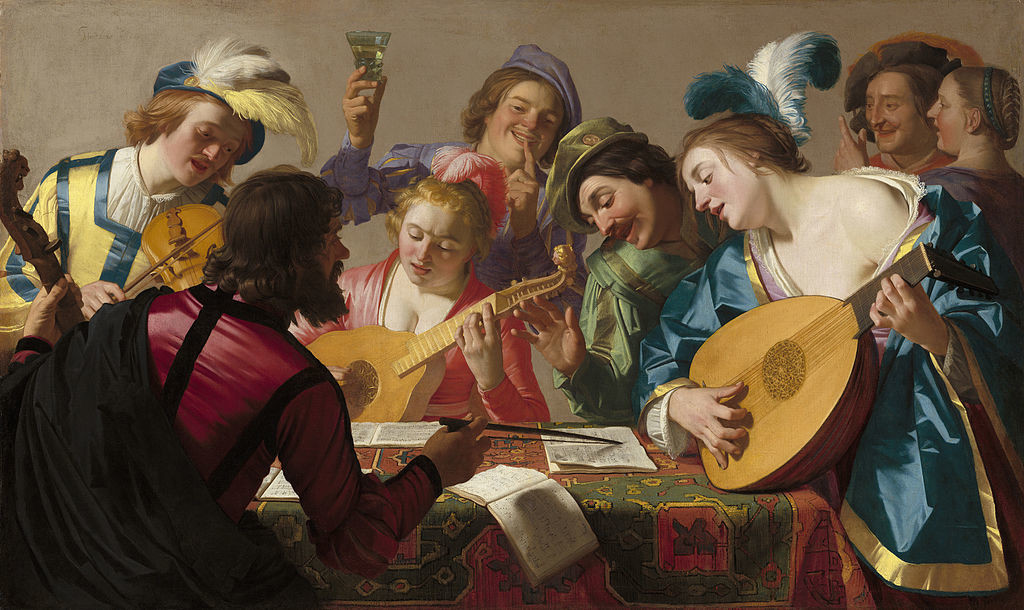
Introduction
Many instruments originated during the Renaissance; others were variations of, or improvements upon, instruments that had existed previously. Some have survived to the present day; others have disappeared, only to be recreated in order to perform music of the period on authentic instruments. As in the modern day, instruments may be classified as brass, strings, percussion, and woodwind.
Medieval instruments in Europe had most commonly been used singly, often self accompanied with a drone, or occasionally in parts. From at least as early as the thirteenth century through the fifteenth century there was a division of instruments into haut (loud, shrill, outdoor instruments) and bas (quieter, more intimate instruments). Only two groups of instruments could play freely in both types of ensembles: the cornett and sackbut, and the tabor and tambourine.
At the beginning of the sixteenth century, instruments were considered to be less important than voices. They were used for dances and to accompany vocal music. Instrumental music remained subordinated to vocal music, and much of its repertory was in varying ways derived from or dependent on vocal models.
Brass
Brass instruments in the Renaissance were traditionally played by professionals. The following are some of the more common brass instruments that were played:
- Slide trumpet: similar to the trombone of today except that instead of a section of the body sliding, only a small part of the body near the mouthpiece and the mouthpiece itself is stationary. Also the body was an S-shape so it was rather unwieldy, but was suitable for the slow dance music which it was most commonly used for.
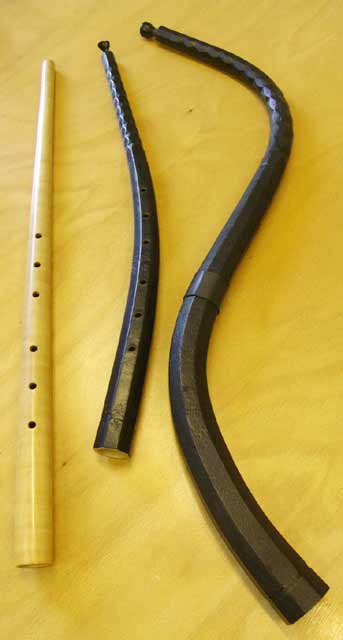
- Cornett: made of wood and played like the recorder (discussed at greater length below) but blown like a trumpet. It was commonly made in several sizes; the largest was called the serpent. The serpent became practically the only cornetto used by the early seventeenth century while other ranges were replaced by the violin. It was said to be the closest instrument to the human voice with the ability to use dynamics and expression.
- Trumpet: early trumpets had no valves and were limited to the tones present in the overtone series. They were also made in different sizes. Although commonly depicted being used by angels, their use in churches was limited, a prominent exception being the music of the Venetian School. They were most commonly used in the military and for the announcement of royalty. Period trumpets were found to have two rings soldered to them, one near the mouthpiece and another near the bell.
- Sackbut (sometimes sackbutt or sagbutt): a different name for the trombone, which replaced the slide trumpet by the middle of the fifteenth century.
Strings
As a family, strings were used in many circumstances, both sacred and secular. A few members of this family include:
- Viol: this instrument, developed in the fifteenth century, commonly has six strings. It was usually played with a bow. It has structural qualities similar to the Spanish vihuela; its main separating trait is its larger size. This changed the posture of the musician in order to rest it against the floor or between the legs in a manner similar to the cello. Its similarities to the vihuela were sharp waist-cuts, similar frets, a flat back, thin ribs, and identical tuning.
- Lyre: its construction is similar to a small harp, although instead of being plucked, it is strummed with a plectrum. Its strings varied in quantity from four, seven, and ten, depending on the era. It was played with the right hand, while the left hand silenced the notes that were not desired. Newer lyres were modified to be played with a bow.
- Lute: the lute can refer generally to any string instrument having the strings running in a plane parallel to the sound table (in the Hornbostel–Sachs system), more specifically to any plucked string instrument with a neck (either fretted or unfretted) and a deep round back, or more specifically to an instrument from the family of European lutes.
- Lira da Braccio: the instrument was shaped essentially like a violin, but with a wider fingerboard and flatter bridge. Generally, it had seven strings, five of them tuned like a violin with a low d added to the bottom (that is, d–g–d’–a’–e”) with two strings off the fingerboard which served as drones and were usually tuned in octaves
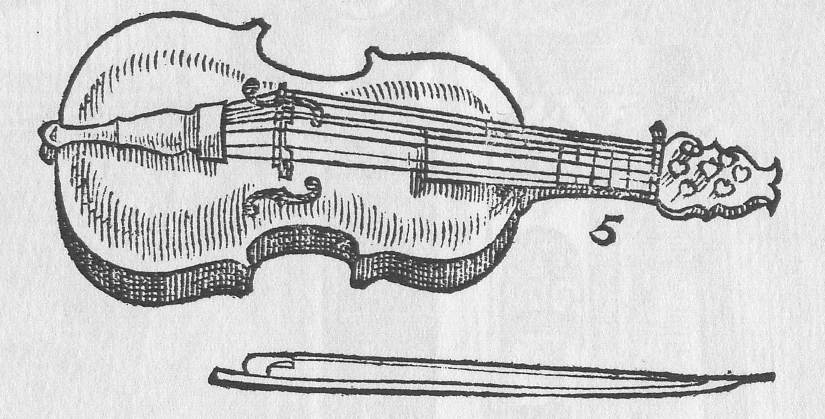
- Irish harp: also called the Clàrsach in Scottish Gaelic, or the Cláirseach in Irish, during the Middle Ages it was the most popular instrument of Ireland and Scotland. Due to its significance on Irish history it is seen even on the Guinness label, and is Ireland’s national symbol even to this day. To be played it is usually plucked. Its size can vary greatly from a harp that can be played in one’s lap to a full-size harp that is placed on the floor
- Hurdy-gurdy: (also known as the wheel fiddle), in which the strings are sounded by a wheel which the strings pass over. Its functionality can be compared to that of a mechanical violin, in that its bow (wheel) is turned by a crank. Its distinctive sound is mainly because of its “drone strings” which provide a constant pitch similar in their sound to that of bagpipes.
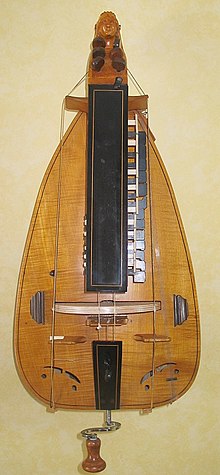
- Gittern and mandore: these instruments were used throughout Europe. Forerunners of modern instruments including the mandolin and guitar.
Percussion
Some Renaissance percussion instruments include the triangle, the Jew’s harp, the tambourine, the bells, the rumble-pot, and various kinds of drums.
- Tambourine: the tambourine was originally a frame drum without the jingles attached to the side. This instrument soon evolved and took on the name of the timbrel during the medieval crusades, at which time it acquired the jingles. The tambourine was often found with a single skin, as it made it easy for a dancer to play. The skin that surrounds the frame is called the vellum, and produces the beat by striking the surface with the knuckles, fingertips, or hand. It could also be played by shaking the instrument, allowing the tambourine’s jingles to “clank” and “jingle.”

- Jew’s harp: an instrument banned because of its construction of silver, and due to the great demand on silver in nineteenth-century Austria this was another reason for its outlawing. A steel instrument that produces sound using shapes of the mouth and attempting to pronounce different vowels with ones mouth. The loop at the bent end of the tongue of the instrument is plucked in different scales of vibration creating different tones.
Woodwinds (aerophones)
Woodwind instruments (aerophones) produce sound by means of a vibrating column of air within the pipe. Holes along the pipe allow the player to control the length of the column of air, and hence the pitch. There are several ways of making the air column vibrate, and these ways define the subcategories of woodwind instruments. A player may blow across a mouth hole, as in a flute; into a mouthpiece with a single reed, as in a modern-day clarinet or saxophone; or a double reed, as in an oboe or bassoon. All three of these methods of tone production can be found in Renaissance instruments.
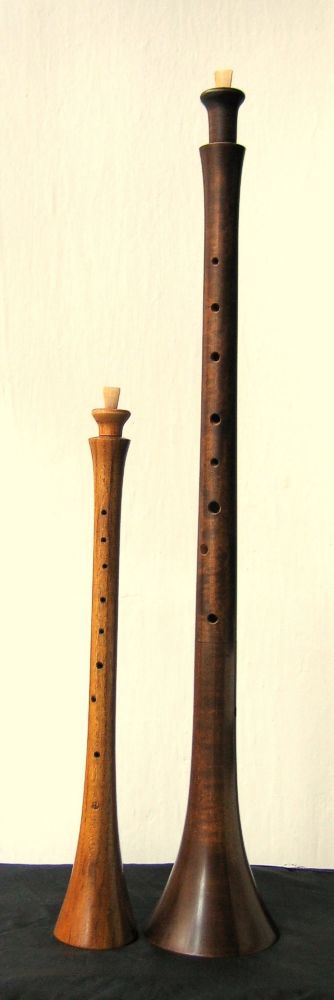
- Shawm: a typical oriental shawm is keyless and is about a foot long with seven finger holes and a thumb hole. The pipes were also most commonly made of wood and many of them had carvings and decorations on them. It was the most popular double reed instrument of the renaissance period; it was commonly used in the streets with drums and trumpets because of its brilliant, piercing, and often deafening sound. To play the shawm a person puts the entire reed in their mouth, puffs out their cheeks, and blows into the pipe whilst breathing through their nose.
- Reed pipe: made from a single short length of cane with a mouthpiece, four or five finger holes, and reed fashioned from it. The reed is made by cutting out a small tongue, but leaving the base attached. It is the predecessor of the saxophone and the clarinet.
- Hornpipe: Same as reed pipe but with a bell at the end.
- Bagpipe/Bladderpipe: believed to have been invented by herdsmen who thought to use a bag made out of sheep or goat skin and would provide air pressure so that when its player takes a breath, the player only needs to squeeze the bag tucked underneath their arm to continue the tone. The mouth pipe has a simple round piece of leather hinged on to the bag end of the pipe and acts like a non-return valve. The reed is located inside the long metal mouthpiece, known as a bocal.
- Panpipe: designed to have sixteen wooden tubes with a stopper at one end and open on the other. Each tube is a different size (thereby producing a different tone), giving it a range of an octave and a half. The player can then place their lips against the desired tube and blow across it.
- Transverse flute: the transverse flute is similar to the modern flute with a mouth hole near the stoppered end and finger holes along the body. The player blows in the side and holds the flute to the right side.

- Recorder: The recorder is a common instrument still used today, often taught to children in elementary schools. Rather than a reed it uses a whistle mouth piece, which is a beak shaped mouth piece, as its main source of sound production. It is usually made with seven finger holes and a thumb hole.
Contributors and Attributions
- Renaissance music. Provided by: Wikipedia. Located at: https://en.Wikipedia.org/wiki/Renaissance_music. License: CC BY-SA: Attribution-ShareAlike
- Lute. Provided by: Wikipedia. Located at: https://en.Wikipedia.org/wiki/Lute. License: CC BY-SA: Attribution-ShareAlike
- Three Cornetts. Provided by: Wikimedia. Located at: https://commons.wikimedia.org/wiki/File:Three_cornetts.jpg. License: CC BY-SA: Attribution-ShareAlike
- Lira da braccio. Authored by: Michael Praetorius. Located at: https://commons.wikimedia.org/wiki/File:Lira_da_braccio.png#/media/File:Lira_da_braccio.png. License: Public Domain: No Known Copyright
- JewsHarpCivilWar . Provided by: Wikimedia Commons . Located at: https://commons.wikimedia.org/wiki/File:JewsHarpCivilWar.jpg#/media/File:JewsHarpCivilWar.jpg. License: Public Domain: No Known Copyright
- The Concert. Provided by: Wikimedia. Located at: https://commons.wikimedia.org/wiki/File:Gerard_van_honthorst_-_the_concert_-_1623.jpg. License: Public Domain: No Known Copyright

